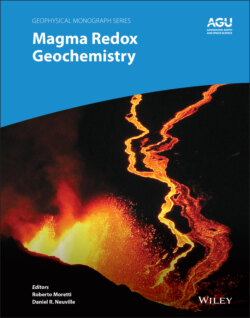Читать книгу Magma Redox Geochemistry - Группа авторов - Страница 38
3.1.1. Theoretical Background
ОглавлениеOxygen fugacity, or fO2, describes the potential for an element to occur in an oxidized or reduced state – that is, with a higher or lower charge. If oxygen were an ideal gas, its chemical potential (μ) would simply be related to its partial pressure (P) via
(3.1)
Where is the standard state chemical potential of O2, R is the gas constant, T is the temperature in Kelvin, and P0 is the standard state pressure of pure O2. Because no gas, and certainly no rock, behaves as an ideal gas, we substitute fugacity (f) for partial pressure, which corrects pressure for non‐ideality, much as chemical activity corrects concentration for non‐ideality. The chemical potential of oxygen is then
(3.2)
when = 1 (the fugacity of pure O2 at 1 bar and T of interest). In this way, we can relate the free energy of any equilibria of pure phases involving O2 to oxygen fugacity via the change in Gibbs free energy (
(3.3)
where Keq is the equilibrium constant. When P and T are specified, such equilibria of pure phases fix the activity of O2, or “buffer” the fO2.
